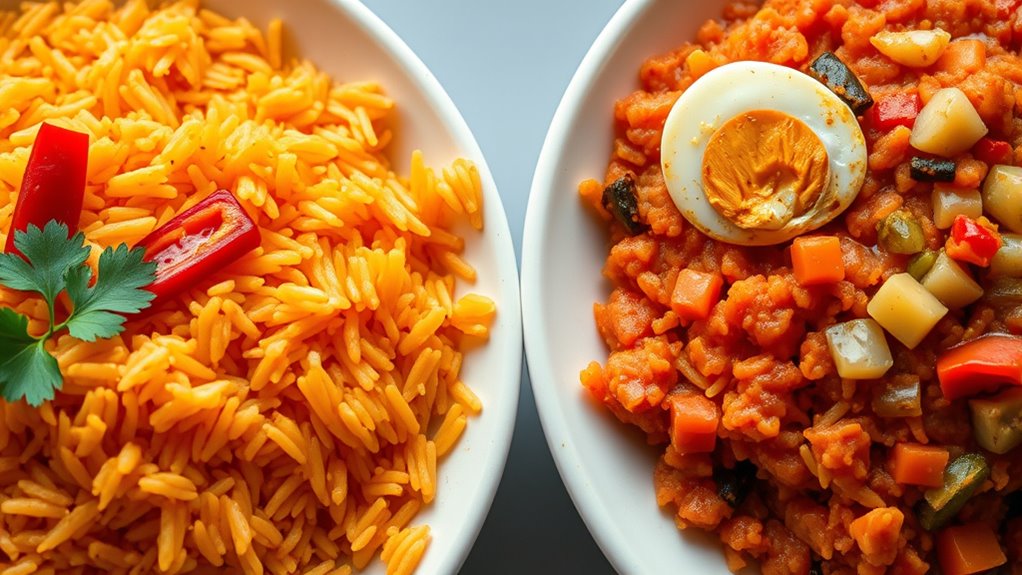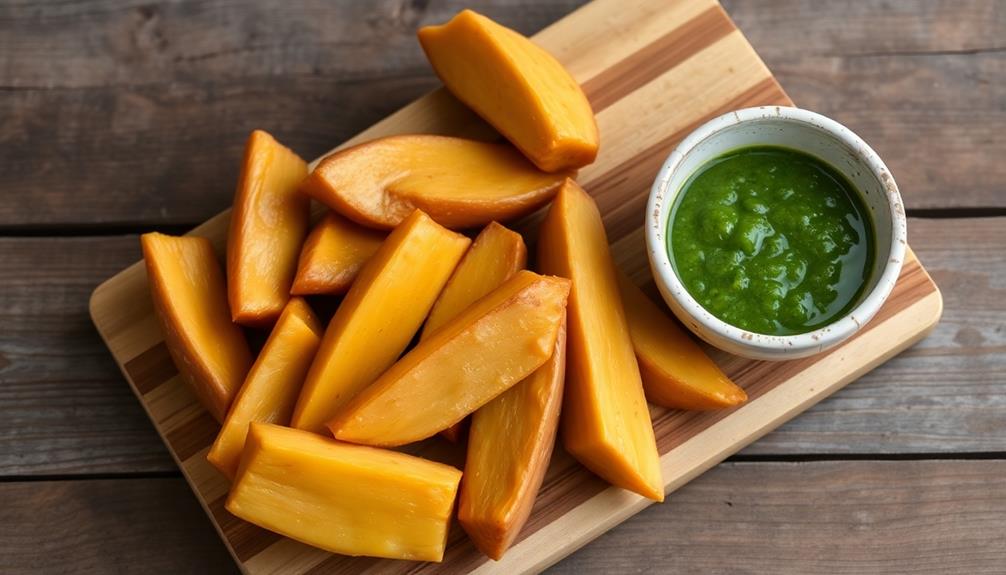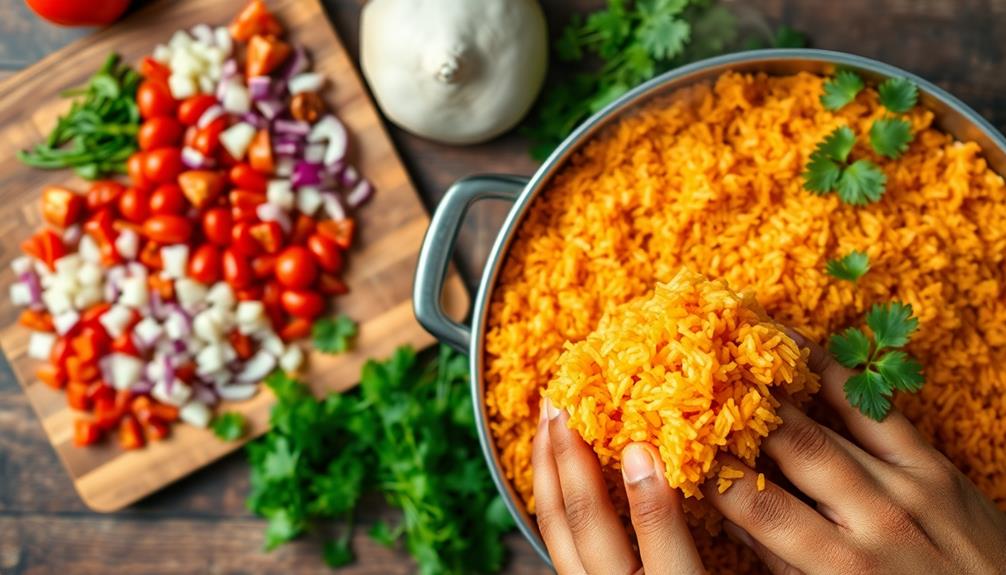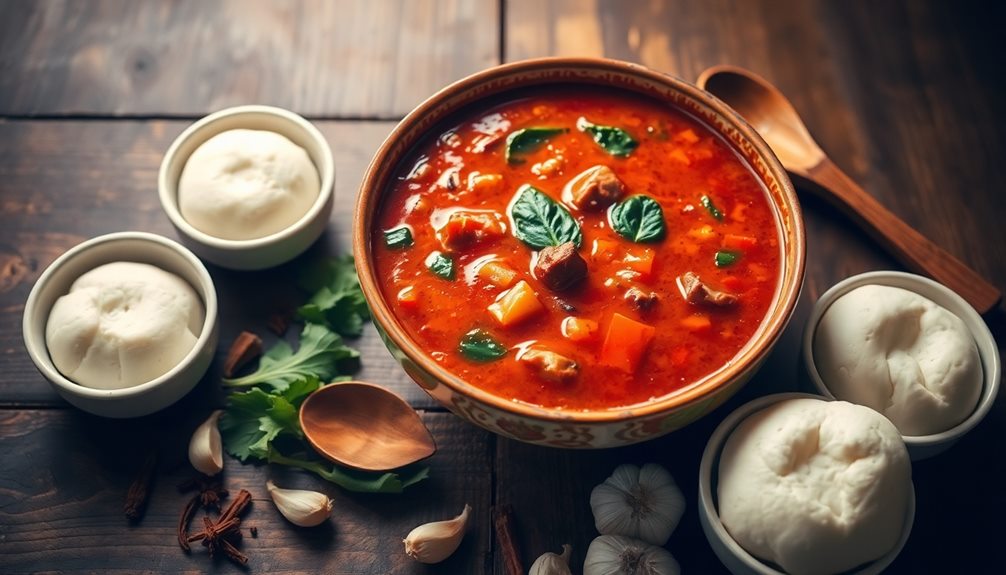When comparing Nigerian and Ghanaian Jollof, you’ll notice Nigerian’s version packs bold, spicy flavors with softer, almost porridge-like rice, while Ghanaian Jollof offers a milder taste with firmer, separate grains. The rivalry stems from these differences in spice levels, rice texture, and cooking techniques rooted in unique cultural traditions. Exploring these nuances reveals the rich culinary heritage of West Africa, and if you continue exploring, you’ll discover even more about what makes each version special.
Key Takeaways
- Nigerian Jollof has a spicier, bolder flavor with softer, porridge-like rice, while Ghanaian Jollof features milder spices and firmer grains.
- The longer cooking time and tomato base in Nigerian Jollof create a richer, saucier dish, contrasting with Ghanaian’s lighter, separate grains.
- Cultural influences and traditional methods shape each version’s unique spice blends, rice preparation, and cooking techniques.
- Nigerian Jollof often pairs with grilled meats, emphasizing its fiery profile, whereas Ghanaian Jollof complements milder stews or fried fish.
- The regional rivalry reflects deep culinary pride, with subtle differences highlighting Nigeria’s boldness versus Ghana’s balanced approach.

Have you ever wondered what sets Nigerian Jollof apart from its Ghanaian counterpart? It’s an intriguing culinary rivalry rooted in subtle differences that truly matter to those who love this beloved West African dish. When you taste Nigerian Jollof, you’ll notice that the spice levels tend to be bolder and more assertive. The dish often features a generous splash of chili, cayenne, or hot pepper, making it spicier and more vibrant on the palate. This fiery kick is a signature trait that excites spice lovers and gives Nigerian Jollof its distinctive edge. Ghanaian Jollof, by contrast, usually offers a milder, more balanced flavor profile, allowing the natural sweetness of the tomatoes and vegetables to shine through without overwhelming heat. If you prefer a fiery experience, Nigerian Jollof’s spices are likely to satisfy your cravings more fully, but if you enjoy a subtler, more subdued flavor, Ghanaian Jollof might be more your style.
The rice texture is another critical aspect that differentiates these two versions. When you dig into Nigerian Jollof, you’ll notice that the rice tends to be softer and more tender, often cooked down to a somewhat saucier consistency. This is achieved by cooking the rice longer in a well-seasoned tomato base, allowing it to absorb all the rich flavors and spices thoroughly. The result is a dish where each grain is infused with taste and moisture, creating a comforting, almost porridge-like texture. Ghanaian Jollof, however, generally features a firmer, more separate rice texture. The grains remain distinct and slightly chewy, giving a different mouthfeel that emphasizes the individual qualities of each rice grain. This firmer texture is often the result of shorter cooking times or different rice varieties used, ensuring the dish retains a more structured bite. Additionally, the choice of wooden utensils during cooking can influence the rice’s texture and prevent sticking, subtly affecting the final dish. Moreover, the cultural traditions surrounding preparation methods can also influence the final outcome of each version, highlighting their unique culinary identities. Cooking techniques, such as the use of specific spices or rice washing methods, also contribute significantly to the final flavor and texture differences.
Both versions celebrate different culinary traditions and preferences, yet they share a common foundation of rice, tomatoes, and spices. You might find that Nigerian Jollof’s bold, spicy profile pairs perfectly with grilled meats or spicy side dishes, while Ghanaian Jollof’s lighter, more textured rice works well with stews or fried fish. Understanding these subtle yet impactful differences can deepen your appreciation for the rich culinary heritage behind each dish. Whether you favor the fiery spice levels and soft rice of Nigerian Jollof or the milder, firmer rice of Ghanaian Jollof, appreciating these nuances brings you closer to the cultural stories and traditions that make each version unique.
Frequently Asked Questions
What Are the Origins of Jollof Rice in West Africa?
You might find it fascinating that jollof rice’s historical origins trace back to the Senegambian region, influenced by West African traders and Arab traders. This dish holds deep cultural significance across West Africa, symbolizing shared history and culinary tradition. Its roots highlight a blend of local ingredients and external influences, creating a dish that’s more than just food—it’s a reflection of regional identity and historical exchanges.
How Do Regional Ingredients Influence Jollof Recipes?
Regional ingredients greatly influence jollof recipes, shaping each area’s unique flavor. You’ll notice local spices like thyme, ginger, and chili, which add distinct warmth and heat. Ingredient variations, such as types of tomatoes or rice, also alter the dish’s taste and texture. By using fresh, region-specific ingredients, you bring out authentic flavors that reflect local culinary traditions, making each jollof uniquely delicious and culturally rich.
Are There Official Recipes for Authentic Nigerian and Ghanaian Jollof?
You might wonder if official recipes define authentic Nigerian and Ghanaian Jollof. While no single standard exists, cultural variations influence each country’s version, emphasizing ingredient authenticity. Nigerian Jollof often features specific spices and long-grain rice, while Ghanaian Jollof highlights particular tomato bases and seasonings. These regional differences celebrate culinary traditions, ensuring each recipe reflects its unique cultural identity, even if there’s no formalized official recipe.
What Are Common Misconceptions About Jollof Rice Rivalry?
You’ve probably heard the hype about the Jollof rivalry, but don’t buy into cultural stereotypes that say only one version is better. The truth? Culinary authenticity varies, and both Nigerian and Ghanaian Jollof are delicious in their own right. The misconception that one is superior just fuels the rivalry—when really, it’s about celebrating diverse flavors, not fighting over whose recipe is more “authentic.”
How Has Social Media Impacted Jollof Rice Debates?
Social media has amplified the jollof rice debate through food memes and viral challenges, making it more lively and competitive. You see playful banter and passionate opinions shared rapidly, fueling national pride and rivalry. These online trends turn an everyday dish into a cultural symbol, encouraging people to participate and showcase their culinary traditions. As a result, social media keeps the conversation fresh, engaging, and sometimes even humorous, strengthening the rivalry worldwide.
Conclusion
So, after all that fiery rivalry, it’s funny how both Nigerian and Ghanaian Jollof secretly share the same love for that smoky, flavorful magic. You’d think centuries of competition would turn the kitchens cold, but nope—it’s just a delicious reminder that sometimes, the best thing about a rivalry is how it brings people together over a shared passion. In the end, maybe it’s not about who wins, but how good both sides can make the pot.









